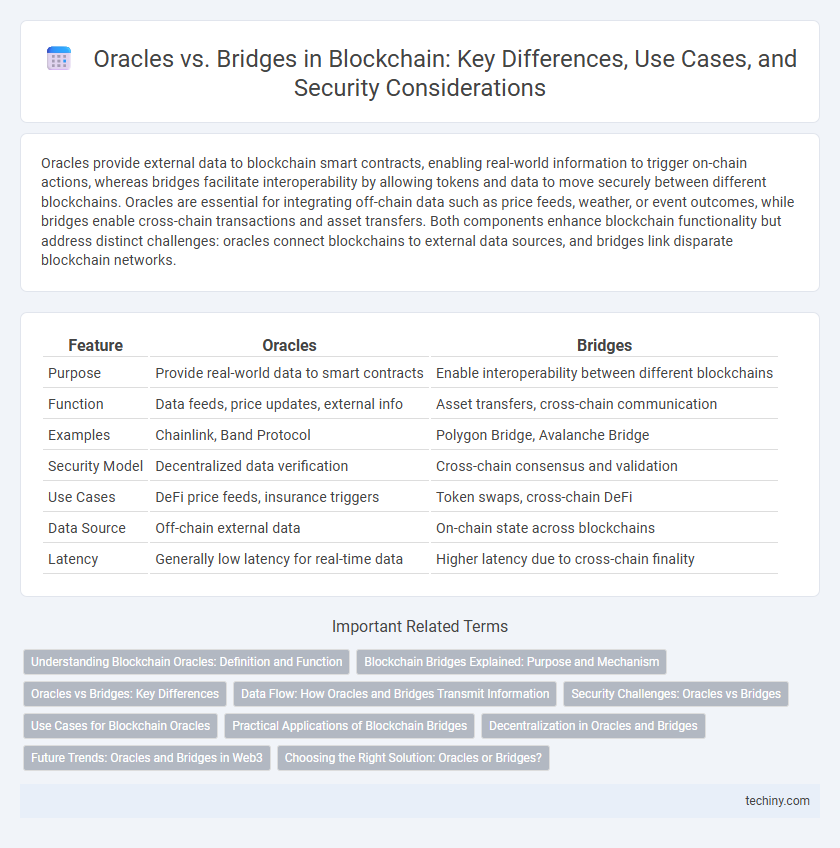Oracles provide external data to blockchain smart contracts, enabling real-world information to trigger on-chain actions, whereas bridges facilitate interoperability by allowing tokens and data to move securely between different blockchains. Oracles are essential for integrating off-chain data such as price feeds, weather, or event outcomes, while bridges enable cross-chain transactions and asset transfers. Both components enhance blockchain functionality but address distinct challenges: oracles connect blockchains to external data sources, and bridges link disparate blockchain networks.
Table of Comparison
| Feature | Oracles | Bridges |
|---|---|---|
| Purpose | Provide real-world data to smart contracts | Enable interoperability between different blockchains |
| Function | Data feeds, price updates, external info | Asset transfers, cross-chain communication |
| Examples | Chainlink, Band Protocol | Polygon Bridge, Avalanche Bridge |
| Security Model | Decentralized data verification | Cross-chain consensus and validation |
| Use Cases | DeFi price feeds, insurance triggers | Token swaps, cross-chain DeFi |
| Data Source | Off-chain external data | On-chain state across blockchains |
| Latency | Generally low latency for real-time data | Higher latency due to cross-chain finality |
Understanding Blockchain Oracles: Definition and Function
Blockchain oracles serve as secure data sources that provide external information to smart contracts, enabling them to execute predefined actions based on real-world events. Unlike blockchain bridges that connect separate blockchain networks for interoperability, oracles specifically focus on feeding reliable off-chain data into the blockchain ecosystem. These trusted data inputs are crucial for decentralized applications (dApps) that require real-time information such as price feeds, weather conditions, or event outcomes to function accurately and autonomously.
Blockchain Bridges Explained: Purpose and Mechanism
Blockchain bridges enable interoperability by connecting separate blockchain networks, allowing assets and data to transfer seamlessly across different chains. They function through a locking and minting mechanism, where tokens are locked on the source chain and corresponding tokens are minted on the target chain, maintaining security and transparency. Unlike oracles that feed external real-world data to smart contracts, bridges specifically facilitate cross-chain communication and asset movement within the blockchain ecosystem.
Oracles vs Bridges: Key Differences
Oracles and bridges serve distinct roles in blockchain ecosystems, where oracles provide external data feeds to smart contracts, enabling real-world information integration for automated decision-making. Bridges facilitate interoperability by enabling token transfers and data exchange between separate blockchain networks, supporting cross-chain communication and asset liquidity. While oracles focus on data accuracy and reliability from off-chain sources, bridges prioritize secure and seamless connectivity across multiple blockchains.
Data Flow: How Oracles and Bridges Transmit Information
Oracles transmit real-world data to blockchain networks by securely querying off-chain sources and delivering verified information on-chain through cryptographic proofs. Bridges facilitate direct data and asset transfers between distinct blockchain protocols by validating and relaying cross-chain messages, enabling seamless interoperability. Both mechanisms ensure data integrity but operate at different layers: oracles connect off-chain data to a single blockchain, while bridges connect multiple blockchains for bidirectional communication.
Security Challenges: Oracles vs Bridges
Oracles face security challenges primarily due to data authenticity and manipulation risks, as they serve as external data providers to blockchain networks. Bridges encounter security vulnerabilities linked to smart contract exploits and cross-chain communication failures, which can result in significant asset loss. Both solutions must implement robust cryptographic proofs and decentralization mechanisms to mitigate fraud and ensure trustworthiness in decentralized environments.
Use Cases for Blockchain Oracles
Blockchain oracles enable smart contracts to securely interact with real-world data, supporting use cases such as decentralized finance (DeFi) price feeds, supply chain tracking, and insurance claim automation. They provide reliable external information to trigger contract execution based on off-chain events, ensuring accuracy and trustworthiness. Unlike bridges that connect different blockchains for asset transfers, oracles primarily focus on delivering verified external data into the blockchain ecosystem.
Practical Applications of Blockchain Bridges
Blockchain bridges enable seamless interoperability between distinct blockchain networks by facilitating asset transfers and data exchanges, enhancing DeFi protocols, cross-chain NFT marketplaces, and multi-chain gaming platforms. Oracles primarily provide external real-world data to smart contracts, whereas bridges directly link blockchain ecosystems, allowing practical applications such as liquidity migration, cross-chain token swaps, and interconnected decentralized applications (dApps). These bridges drive innovation by expanding blockchain functionality beyond isolated chains, improving scalability and user experience in decentralized finance and beyond.
Decentralization in Oracles and Bridges
Oracles achieve decentralization by aggregating data from multiple independent sources, reducing reliance on a single entity and minimizing the risk of data manipulation. Bridges, while essential for cross-chain communication, often face challenges in decentralization due to reliance on a limited number of validators or trusted relayers, which can introduce central points of failure. Maximizing decentralization in both oracles and bridges is crucial to maintaining blockchain security and ensuring trustless interoperability across networks.
Future Trends: Oracles and Bridges in Web3
Oracles and bridges will play pivotal roles in enhancing interoperability and data accuracy across decentralized networks in Web3. Emerging trends highlight oracles evolving with increased decentralization and secure data feeds, while bridges focus on scalability solutions and cross-chain asset transfers. Innovations in these technologies are expected to drive seamless integration and real-time communication between diverse blockchain ecosystems.
Choosing the Right Solution: Oracles or Bridges?
Selecting between oracles and bridges depends on the specific blockchain interoperability and data integration needs; oracles excel in securely feeding real-world data into smart contracts, while bridges specialize in transferring assets and information across different blockchains. Oracles provide verified external data sources essential for DeFi, insurance, and prediction markets, ensuring smart contracts operate with accurate off-chain inputs. Bridges enable seamless token swaps and cross-chain communication, facilitating liquidity and broader ecosystem connectivity, making the choice crucial for tailored blockchain applications.
Oracles vs Bridges Infographic

 techiny.com
techiny.com